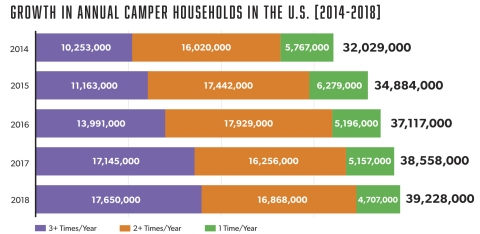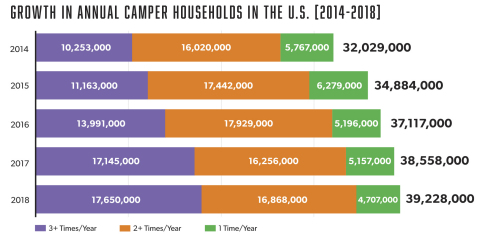BILLINGS, Mont.--(BUSINESS WIRE)--More North Americans are discovering the benefits of time spent outdoors and as they do, they’re committing more time to camping each year. More than 7.2 million households in the U.S. have started camping over the past five years, bringing the total number of camping households in the U.S. to a new high of 78.8 million, according to the 2019 North American Camping Report®, an annual independent study supported by Kampgrounds of America, Inc. (KOA). North Americans are also camping more frequently than ever before, with 72% growth among those who camp three or more times each year – the most avid group of campers – since 2014.
Key factors driving this upward trend include an influx of younger and more diverse campers; millennials having kids and taking them camping; and North Americans’ love for the outdoors.
Younger and More Diverse Campers
Of the 1.4 million households that started camping in 2018 alone, 56% are Millennials and 51% are from non-white groups. Millennials currently make up the largest segment of campers at 41%, up 7 percentage points since 2014, and Gen Xers make up 36%, up 9 percentage points.
The explosion of camping is leading to greater diversity as well. Since the ethnic mix of campers was first measured in 2012, the percentage of non-white camping households has increased from 12 percent to 29 percent. What’s more, for the first time since measurement of new campers began in 2014, the percentage of new non-white campers (51%) in 2018 outpaced the percentage of new Caucasian campers (49%).
Starting a Family and Camping with Kids
Changes in life stage, specifically starting a family, is a significant factor fueling the growth of camping. Fifty-four percent of Millennials are now camping with kids and when asked what was the key trigger that got them to camp more, the majority said having kids. Millennials with children in the household are an avid group of campers: 63% camp more than seven nights per year, and two-thirds plan to camp more in 2019.
In fact, camping families with children in the household form the most avid group of campers overall. This group took the most camping trips and spent the most nights camping in 2018, and are substantially more likely to camp more often in 2019.
Love for the Outdoors and the Social, Emotional Benefits of Camping
Half of all campers say their love of the outdoors is what sparked their interest in camping. This has remained the leading driver over the last five years. Campers are increasingly seeing camping and other forms of outdoor recreation (hiking, biking fishing, etc.) as one in the same. This trend is being driven primarily by younger campers.
Campers are sharing the love, too, with 48% of new campers reporting that other people got them interested in camping. Overall, campers – no matter age or ethnic background – view camping as a time to reduce stress, relax and clear their minds, and spend more time with family.
A Promising Outlook
The findings of the 2019 North American Camping Report suggest this momentum will continue given North Americans’ enthusiasm and strong commitment to camping. Survey results show the growing camper segments have a great deal of enthusiasm for taking more trips and camping more nights each year.
More than half (51%) of parents report that the enthusiasm for camping among their children has never been higher. And teen campers agree – 96% say they enjoy the time camping with family and friends, and they say they are healthier thanks to the benefits of camping and other outdoor activities.
Further, one-third of all American and Canadian campers now self-identify as a “life-long” campers, the highest rate since the survey’s inception in 2014. Both millennials and Gen Xers are more likely to identify themselves as lifelong campers when compared to past years.
The Evolving Camping Experience
New trends in different camping experiences, including glamping and van life, is also contributing to the increasing interest, and expanding the modern definition of camping. According to findings in the 2019 report, close to half of all campers are interested in a glamping or van life experience, a rate that has doubled since last year. Campers’ excitement to try new and different methods of camping has spawned new and expanding extensions of the outdoor industry.
“Since we started measuring the North American camping market five years ago, we’ve seen increasing diversification of age, life stage, ethnicity and even sexual orientation among campers, yet what remains consistent is a shared connection through a passion to immerse themselves in the outdoors through camping,” said Toby O’Rourke, President and CEO of KOA. “We ultimately believe that the fundamental reason why people camp – to connect with each other and with nature – will not change, but how they camp may. We continue to evolve our offerings based on these insights to provide campers with better experiences, thus meeting needs and continuing to help foster the growth of camping throughout North America.”
Key findings of the 2019 North American Camping Report and 5-year camping market trends include:
The popularity of camping continues to grow and the future of camping remains strong – even among the youngest group of campers.
- Overall camping incidence remains stable with 62% of U.S. households (78.8 million) having someone who camps at least occasionally. This is an increase of four percentage points over five years (71.5 million households, or 58%, in 2014).
- Since 2014, the percentage of campers who camp three or more times each year has increased by 72%.
- Teen campers continue to be highly engaged in camping with 96% saying they enjoy the time camping with family and friends and 97% acknowledging that camping helps to relax the adults in their life.
- Nearly all of the teen campers surveyed claim they intend to camp as adults (90%), and if they have children, 91% intend to bring them camping as well.
For the first time since measurement started in 2014, the percentage of new non-white campers (51%) outpaced the percentage of new Caucasian campers (49%) in 2018.
- This means that those new to camping are more diverse than the overall U.S. population – half of the newest campers are from non-white groups and exceed U.S. Census figures.
- Hispanic campers represent 11% of all camping households and is the largest group of non-white campers. Representation of new Hispanic campers grew in 2018 to 22%, exceeding U.S. Census figures at 16%.
- African American campers now represent 9% of camping households and Asian-American campers 7%, both representing growth from the initial reporting in 2014.
- African American campers are the youngest demographic of campers with 64% millennial representation.
Traditional camping – tents, RVs and cabins – remains strong, but the growth in new and unique camping styles has skyrocketed as camper demographics continue to change.
- Tent camping remains the most popular way of camping for North Americans (59%), while RVing represents 24% and cabin camping 16% of the market.
- Millennials (56%) and Gen Xers (46%) are most likely to have tried new lodging in 2018; most Millennials tried tent camping while Gen Xers tried a full-service cabin with a bathroom.
- While campers of all ages and ethnicities are interested in trying a luxury cabin camping experience in 2019, half of all campers surveyed said that they would also like to experience glamping of some type in the coming year – a rate that has more than doubled since 2017.
- Van life has also surged in popularity over the last five years. While the rate is much lower against glamping, there is was a 6%-point increase from 2017 to 2018 among campers of all ages who would like to experience van life from 2017 to 2018.
- Among the subset of RV campers, 61% own the RV they use most and 36% rent or borrow the RV they use most, a shift from 2017 that now favors ownership. Increases in RV ownership are being driven by Gen Xers who, likely driven by changes in their life stages, increased ownership rates in 2018.
- 58% of Hispanic campers indicated they’d be interested in an RV experience – the highest interest level among all camper groups
- African American campers’ interest in tent camping for backpacking or backcountry experiences – such as biking, canoeing or kayaking – grew 22% in 2018 compared to 2017.
Younger campers are helping to drive the future of camping with millennials (61%) and Gen X (56%) campers being the most likely to camp more in 2019.
- 56% of camping households indicate they plan to camp more in 2019, continuing an upward trend since 2014.
- A full 84% of campers say they plan to camp in 2019 as much or more than 2018.
- Hispanic campers overall are most likely to report an intent to increase their camping in 2019 (50%).
To view past versions of the North American Camping Report or obtain corresponding 2019 report imagery and graphs, visit KOApressroom.com. For more information on KOA’s Campground of the Future initiative, a collection of interactive and animated illustrations depicting a 2030 campground, visit Campthefuture.com.
SURVEY METHODOLOGY
U.S. and Canadian Household Results: This survey was conducted by Cairn Consulting Group, an independent market research firm with extensive experience in the hospitality and services industries. The survey was conducted in January 2019. The sampling methodology targeted a randomly selected sample of U.S. and Canadian households. Sampling was designed to obtain n=2,900 completed survey among representative U.S. households and representative Canadian households. A sample of n=2,400 U.S. households is associated with a margin of error of +/- 1.99%. Among Canadian households, a sample of n=500 is associated with a margin of error of +/- 4.37%.
Teen Survey Results: The results are based on a total of 400 surveys completed among a random sample of U.S. households with children between the ages of 13 and 17. Each survey was completed with a teen respondent whose parents gave prior permission. A sample of n=400 teen campers is associated with a margin of error of +/- 4.9%.
All surveys were completed online via an outbound solicitation sent to a randomly selected cross-section of U.S. and Canadian households. The sample of households from which the surveys were completed was statistically balanced to ensure that the results are in line with overall population figures for age, gender and ethnicity.
ABOUT KAMPGROUNDS OF AMERICA
Kampgrounds of America, Inc. (KOA) is the world’s largest system of open-to-the-public campgrounds with more than 500 locations across the U.S. and Canada. The industry leader in outdoor hospitality, KOA’s family of campground brands – KOA Journey, KOA Holiday and KOA Resort – offer sites and amenities designed for every type of camping experience. The company was founded 57 years ago in Billings, Mont., and today serves more than a million camping families each year, who rely on the standards of excellence and unique outdoor adventures KOA is known for. For more information, visit KOA.com.
ABOUT CAIRN CONSULTING GROUP
Cairn Consulting Group is a market research firm with extensive experience in the hospitality and services industries. For the past several years, Cairn Consulting Group has worked with organizations in both indoor and outdoor hospitality, including the gaming/casino areas, food services/restaurant space, accommodations, travel/tourism and the products and services that are a part of the hospitality industry. The organization also serves clients in branding/brand positioning efforts, evaluating consumer behavior, public opinion & policy and product development.




